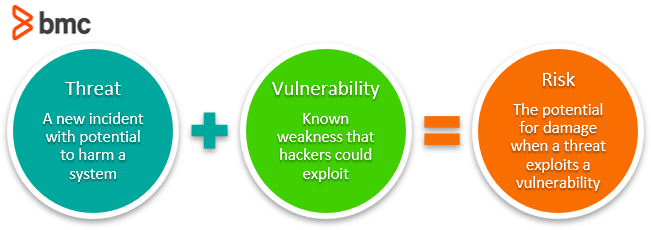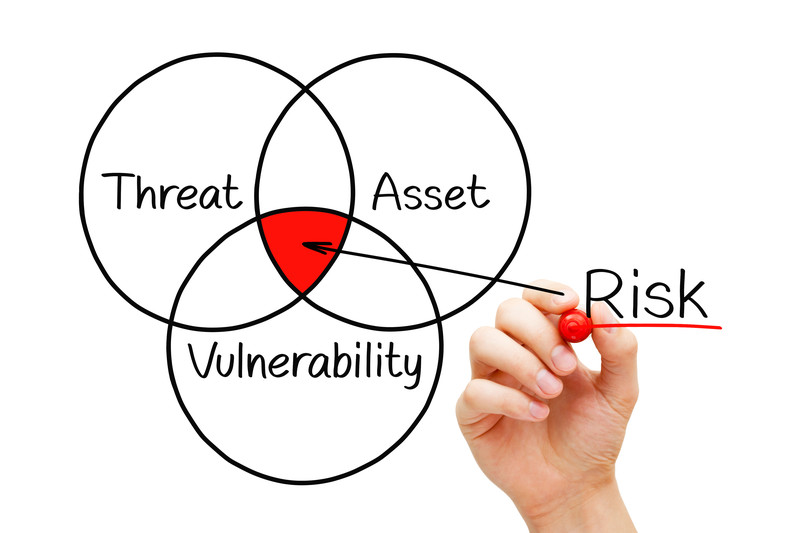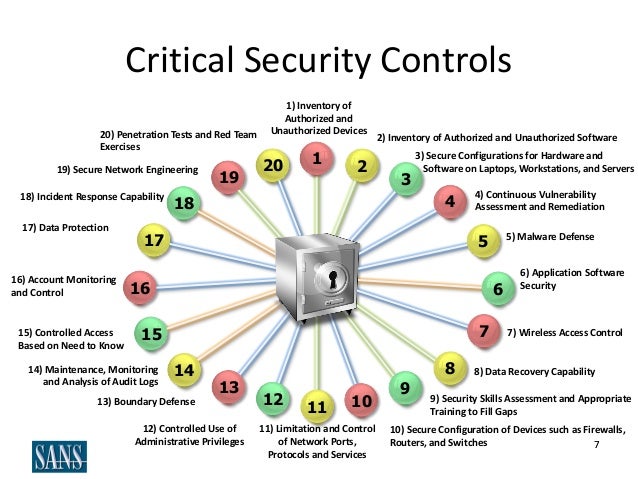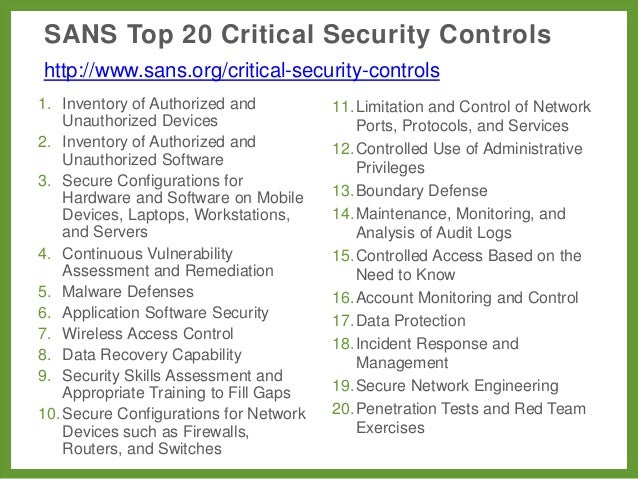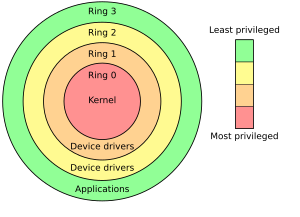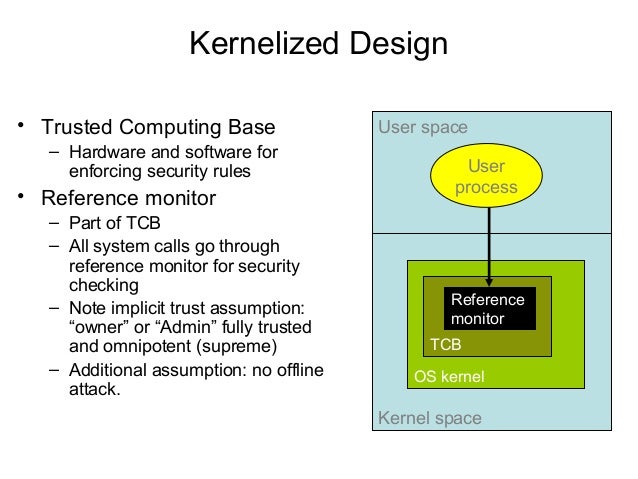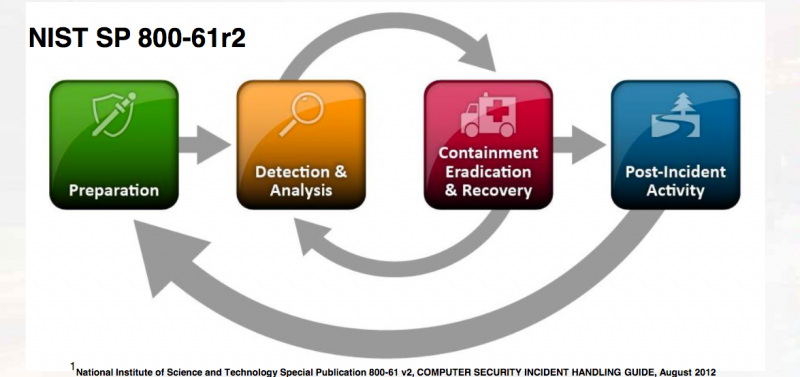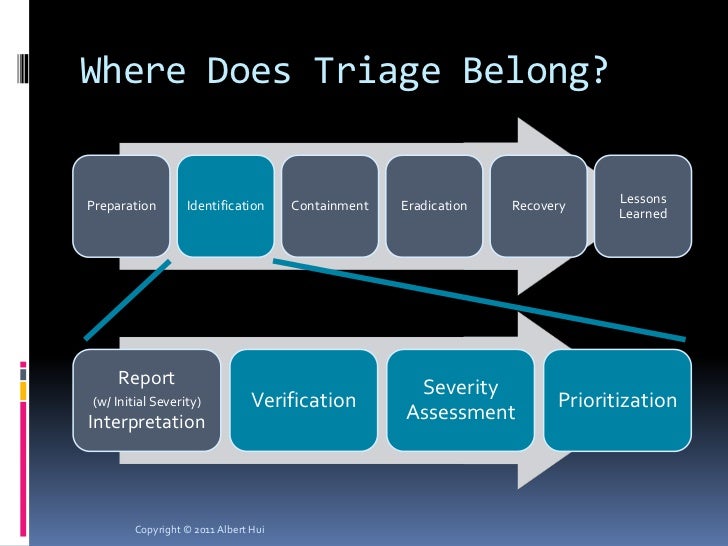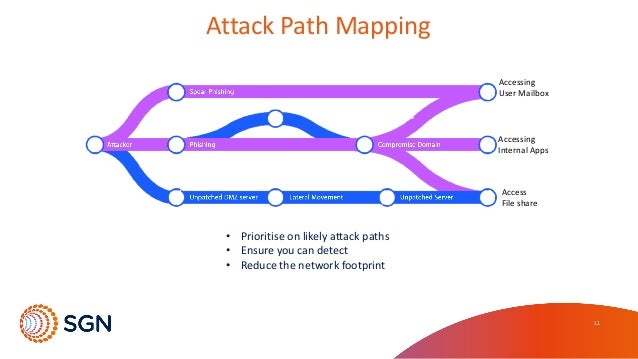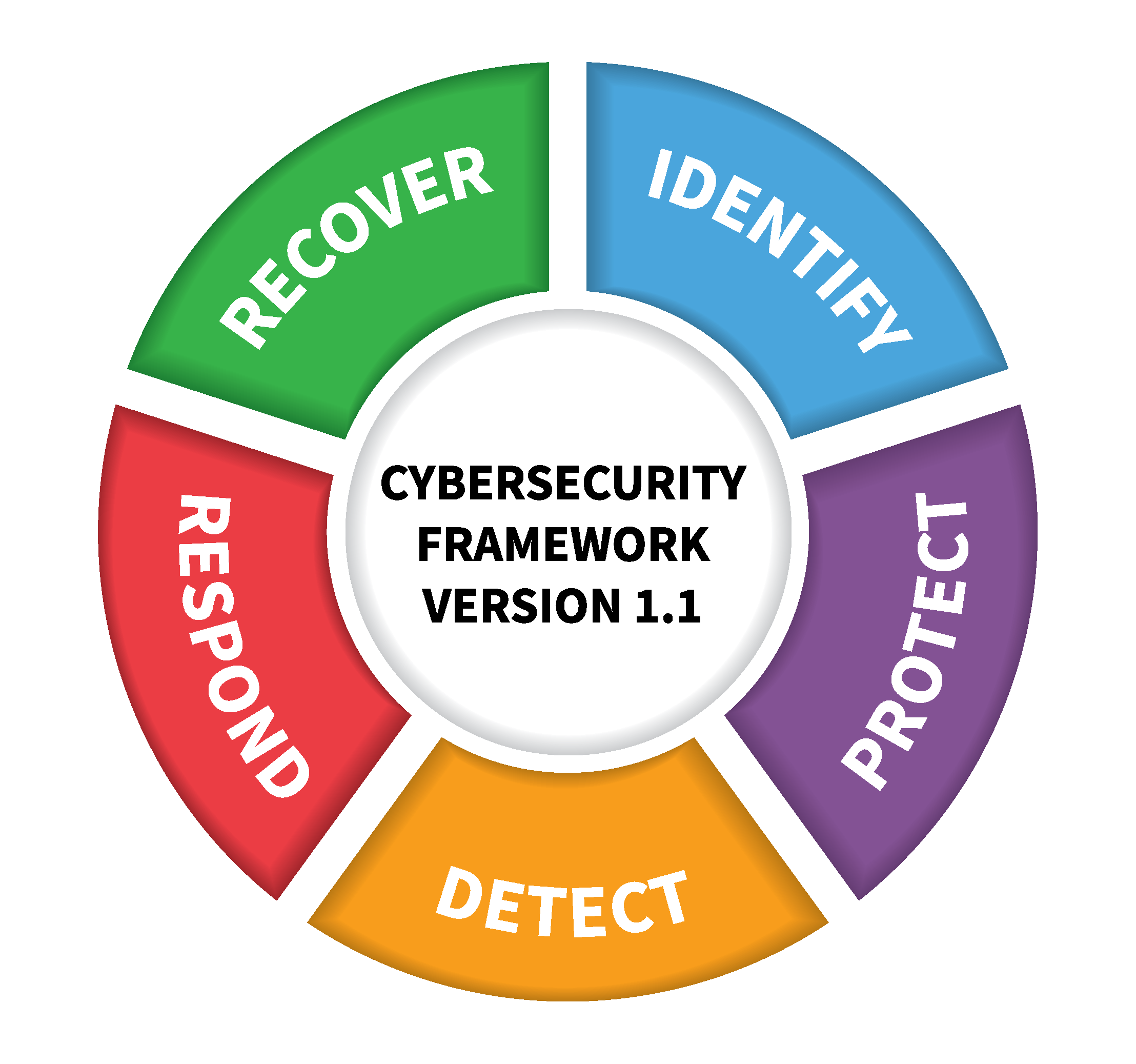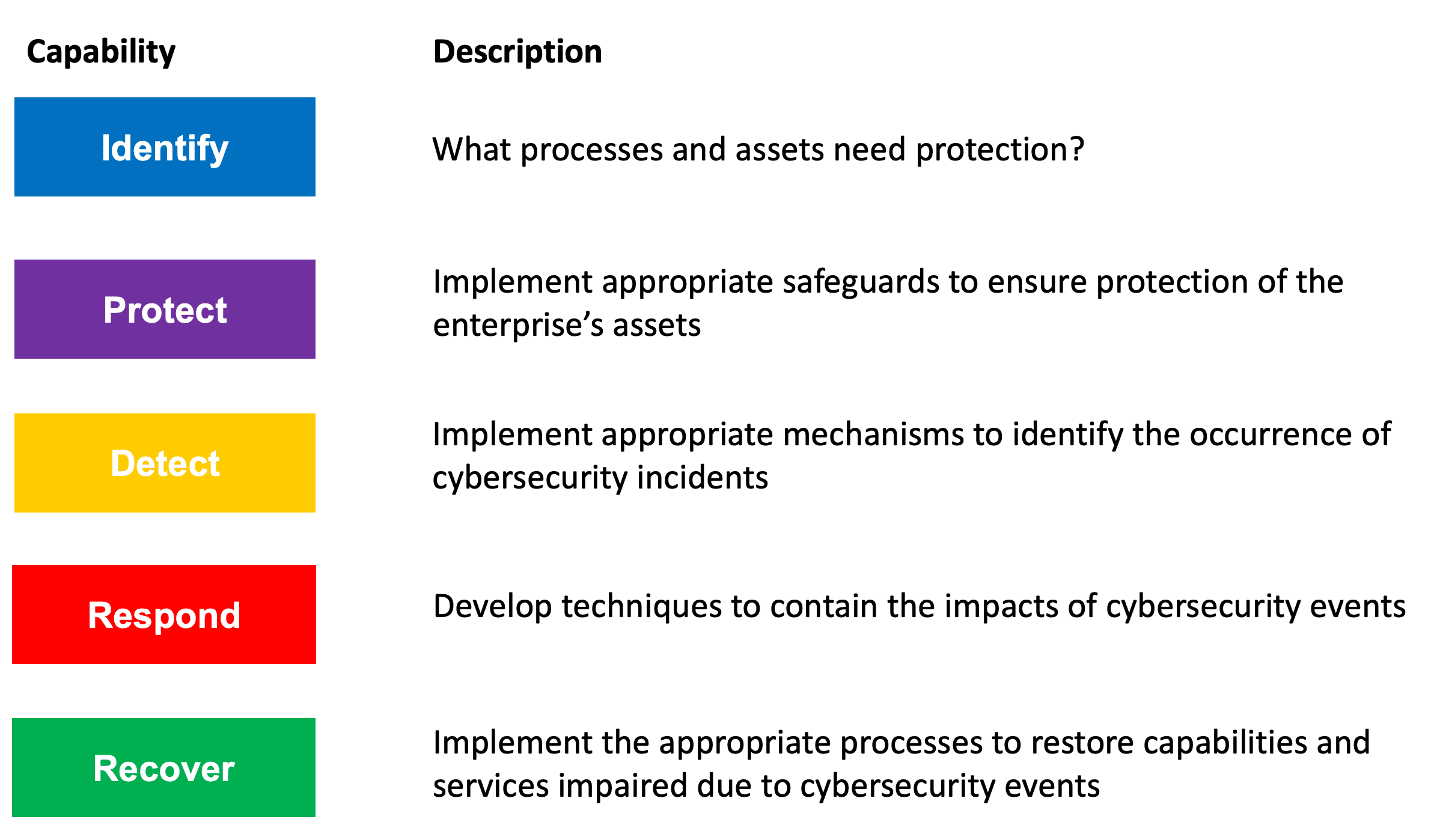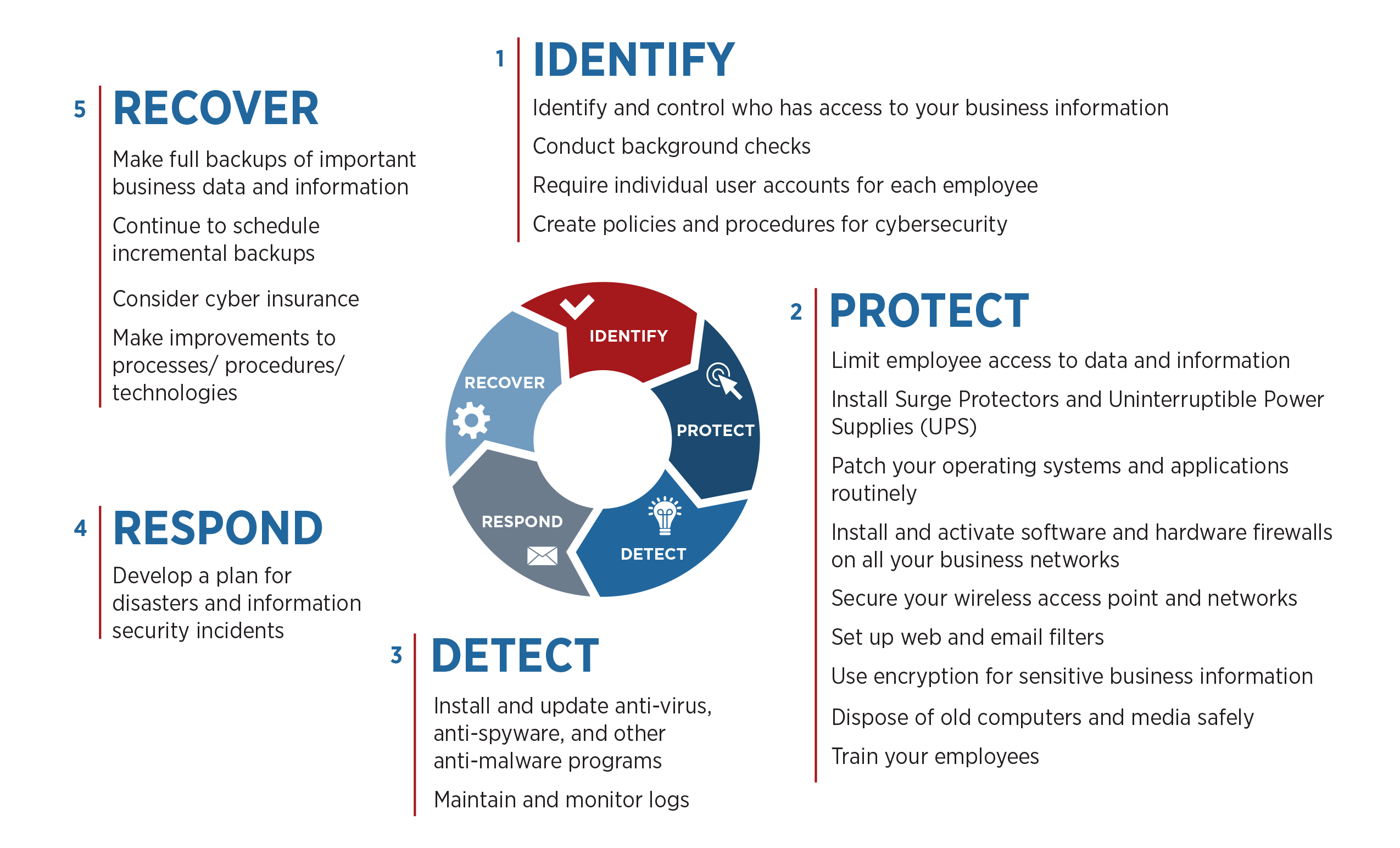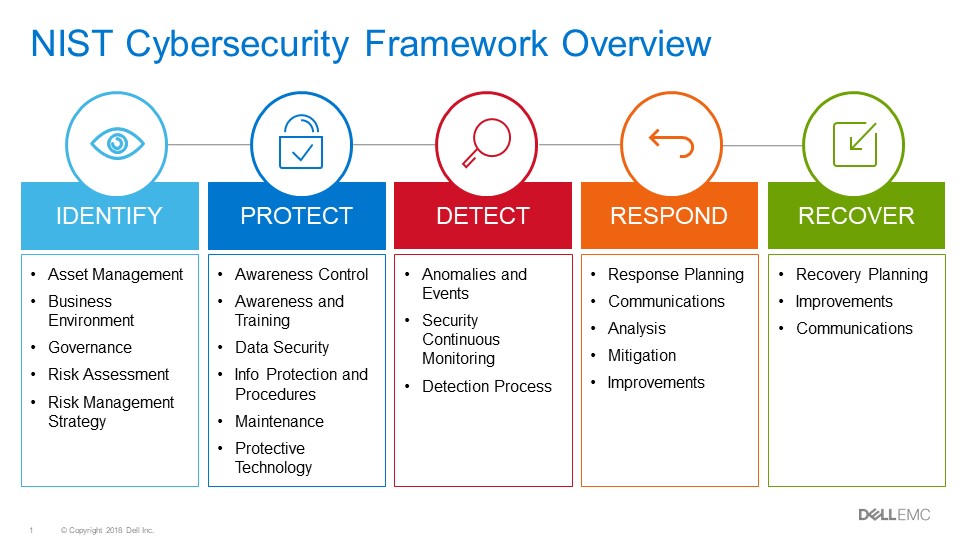- WHAT IS CYBERSECURITY?
Cybersecurity refers to a set of techniques used to protect the integrity of networks, programs and data from attack, damage or unauthorized access.
https://www.paloaltonetworks.com/cyberpedia/what-is-cyber-security
- Data privacy vs Cybersecurity vs Information Security
Data privacy relates to business policies that define appropriate data management such as collection, retention, and deletion. Cybersecurity comprises methods for protecting networks, devices, and data from unauthorized access, and ensuring the confidentiality, integrity, and availability of all that information. Information Security includes cybersecurity and physical security
https://training.fortinet.com/pluginfile.php/1057447/mod_resource/content/9/NSE1_Lesson_Scripts-EN.pdf
- Threat
A threat is any type of danger, which can damage or steal data, create a disruption or cause a harm in general. Common examples of threats include malware, phishing, data breaches and even rogue employees.
Vulnerability
A vulnerability is a weakness in hardware, software, personnel or procedures, which may be exploited by threat actors in order to achieve their goals.
Risk
Risk is a combination of the threat probability and the impact of a vulnerability. In other words, risk is the probability of a threat agent successfully exploiting a vulnerability
Risk = Threat Probability * Vulnerability Impact.
https://lifars.com/2020/07/threat-vulnerability-risk-what-is-the-difference/
- **safety: The state of being safe;
exemption from hurt or injury;freedom from danger.safety chain, a chain providing additional security
***security: The condition of being protected from or not exposed to danger;
https://www.quora.com/What-is-the-difference-between-safety-and-security
- What is a Zero-Day Vulnerability?
http://www.pctools.com/security-news/zero-day-vulnerability/
- A zero-day vulnerability, at its core, is a flaw. It is an unknown exploit in the wild that exposes a vulnerability in software or hardware and can create complicated problems well before anyone realizes something is wrong. In fact, a zero-day exploit leaves NO opportunity for detection.
Vulnerability Timeline
A zero-day attack happens once that flaw, or software/hardware vulnerability,
A company’s developers create software, but unbeknownst to them, it contains a vulnerability.
The threat actor spots that vulnerability either before the developer does or acts on it before the developer
The attacker writes and implements exploit code while the vulnerability is still open and available
After releasing the exploit, either the public recognizes it in the form of identity or information theft or the developer catches it and creates a patch to staunch the
Once a patch
https://www.fireeye.com/current-threats/what-is-a-zero-day-exploit.html
- Cyber-insurance is an insurance product used to protect businesses and individual users from Internet-based risks, and
more generally are typically excluded are not specifically defined cyber -insurance policies may include first-party coverage against losses such as data destruction, extortion, theft, hacking, and denial of service attacks;liability coverage indemnifying companies for losses to others caused, for example, by errors and omissions, failure to safeguard data, or defamation; and other benefits including regular security-audit, post-incident public relations and investigative expenses, and criminal reward funds.
- Zero-day
actually
Zero-day vulnerability refers to a security hole in software—such as browser software or operating system software—that is yet unknown to the software maker or
Zero-day exploit refers to code that attackers
The term “zero-day” refers to the number of days that the software vendor has known about the hole
https://www.wired.com/2014/11/what-is-a-zero-day/
- Information Security
Information Security (also known as
Cybersecurity
A physical security component is available to Information Security and Cybersecurity. Either a data
In Information Security, the main concern is safeguarding the data of the company from the illegal access of any kind, whereas, in Cybersecurity, the main concern is safeguarding the data of the company from illegal digital access.
https://www.hack2secure.com/blogs/cyber-security-vs-information-security
- Information security (or “
InfoSec This is often referred
Cybersecurity is all about protecting data that
Overlap Between Information Security & Cybersecurity
There is a physical security component to both cybersecurity and information security
They both take the value of the data into consideration.
If you’re in information security, your main concern is protecting your company's data from unauthorized access of any sort—and if you’re in cybersecurity, your main concern is protecting your company’s data from
https://www.bitsighttech.com/blog/cybersecurity-vs-information-security
- Cyber Hygiene: A Baseline Set of Practices
https://resources.sei.cmu.edu/asset_files/Presentation/2017_017_001_508771.pdf
- Defining Cyber Hygiene
To achieve security within the domain, we need to adapt a good
It includes organizing security in hardware, software and IT infrastructure, continuous network monitoring, and employee awareness and training.
The Center for Internet Security (CIS) and the Council on Cyber Security (CCS) defines
The campaign’s top priorities address the vast majority of known
Count: Know what’s connected to and running on your network
Configure: Implement key security settings to help protect your systems
Control: Limit and manage those who have administrative privileges for security settings
Patch: Regularly update all apps, software, and operating systems
Repeat: Regularly revisit the Top Priorities to form a solid foundation of
AAA
Access Controls
Monitoring
Plan
Security Patches and Remediation process
Managed Cyber Risks
Non-technical issues mainly concentrate on absence of employee training, security awareness, organization policies and social engineering awareness.
https://resources.infosecinstitute.com/the-importance-of-cyber-hygiene-in-cyberspace/#gref
- Authentication, authorization and accounting (AAA) is a system for tracking user activities on an IP-based network and controlling their access to network resources. AAA is often
is implemented
https://www.techopedia.com/definition/24130/authentication-authorization-and-accounting-aaa
- Authentication, authorization, and accounting (AAA) is a term for a framework for intelligently controlling access to computer resources, enforcing policies, auditing usage, and providing the information necessary to bill for services
http://searchsecurity.techtarget.com/definition/authentication-authorization-and-accounting
- The Critical Security Controls: Basic Cybersecurity Hygiene for your Organization
Fortunately, there is a
https://blog.qualys.com/news/2017/10/12/the-critical-security-controls-basic-cyber-security-hygiene-for-your-organization
- Implementing the CIS 20 Critical Security Controls: Building Upon Foundational Cyber Hygiene
You can significantly lower the risk of being victimized by this
This set of 20 structured
https://www.marketscreener.com/QUALYS-INC-11612572/news/Implementing-the-CIS-20-Critical-Security-Controls-Building-Upon-Foundational-Cyber-Hygiene-25582102/
- CIS Controls V7 Measures & Metrics Measures & Metrics for CIS Controls V7
The CIS Controls
https://www.cisecurity.org/white-papers/cis-controls-v7-measures-metrics/
- CIS Controls Measures and Metrics for Version 7
https://www.cisecurity.org/wp-content/uploads/2018/03/CIS-Controls-Measures-and-Metrics-for-Version-7-cc-FINAL.pdf
- Top 20 Critical Security Controls for Effective Cyber Defense
The complete list of CIS Critical Security Controls, version 6.1
The CIS CSC is a set of 20 controls (sometimes called the SANS Top 20) designed to help organizations safeguard their systems and data from known attack vectors. It can also be an effective guide for companies that do yet not have a coherent security program. Although the CIS Controls are not a replacement for any existing compliance scheme, the controls map to several major compliance frameworks (e.g., the NIST Cybersecurity framework) and regulations (e.g., PCI DSS and HIPAA).
Implementing the Controls: A Pragmatic Approach
Getting value from the CIS Critical Security Controls does not
A more pragmatic approach to implementing the controls includes the following steps:
Discover your information assets and estimate their value. Perform
Compare your current security controls to the CIS Controls. Make
Develop a plan for adopting the most valuable new security controls and improving the operational effectiveness of your existing controls.
Implement the controls.
https://blog.netwrix.com/2018/02/01/top-20-critical-security-controls-for-effective-cyber-defense/
- The 20 CIS Controls & Resources
Basic CIS Controls
1. Inventory and Control of Hardware Assets
2. Inventory and Control of Software Assets
3. Continuous Vulnerability Management
4. Controlled Use of Administrative Privileges
5. Secure Configuration for Hardware and Software on Mobile Devices, Laptops, Workstations and Servers
6. Maintenance, Monitoring and Analysis of Audit Logs
Foundational CIS Controls
7. Email and Web Browser Protections
8. Malware Defenses
9. Limitation and Control of Network Ports, Protocols and Services
10. Data Recovery Capabilities
11. Secure Configuration for Network Devices, such as Firewalls, Routers and Switches
12. Boundary Defense
13. Data Protection
14. Controlled Access Based on the Need to Know
15. Wireless Access Control
16. Account Monitoring and Control
Organizational CIS Controls
17. Implement a Security Awareness and Training Program
18. Application Software Security
19. Incident Response and Management
20. Penetration Tests and Red Team Exercises
https://www.cisecurity.org/controls/cis-controls-list/
- Tabletop Exercises
Six Scenarios to Help Prepare Your Cybersecurity Team
https://www.cisecurity.org/wp-content/uploads/2018/10/Six-tabletop-exercises-FINAL.pdf
- A Measurement Companion to the CIS Critical Security Controls
The CIS Critical Security Controls (
information to help them track progress and to encourage the use of automation
https://www.cisecurity.org/wp-content/uploads/2017/03/A-Measurement-Companion-to-the-CIS-Critical-Security-Controls-VER-6.0-10.15.2015.pdf
- In Forensic science,
Locard's exchange principle (sometimes simply be used as
https://en.wikipedia.org/wiki/Locard%27s_exchange_principle
The NICE Framework is comprised of
Categories (7)
Specialty Areas (33)
Work Roles (52)
Knowledge, Skills, and Abilities (KSAs)
Tasks
https://www.nist.gov/itl/applied-cybersecurity/national-initiative-cybersecurity-education-nice/nice-cybersecurity
- The National Initiative for Cybersecurity Education (NICE) Cybersecurity Workforce Framework provides a blueprint to categorize, organize, and describe cybersecurity work into Categories, Specialty Areas, Work Roles, tasks, and knowledge, skills, and abilities (KSAs). The NICE Framework provides a common language to speak about
cyber roles and jobs and helps define personal requirements in cybersecurity.
https://niccs.us-cert.gov/workforce-development/cyber-security-workforce-framework
- This voluntary Framework
consists of Framework’s
- The Cyber Analytics Repository (CAR) is a knowledge base of analytics developed by MITRE based on the Adversary Tactics, Techniques, and Common Knowledge (ATT&CK™) adversary model.
a hypothesis which explains the idea behind the analytic
references to ATT&CK Techniques and Tactics that the analytic detects
the
a
a unit test
https://car.mitre.org/wiki/Main_Page
ATT&CK is useful for understanding security risk against known adversary behavior, for planning security improvements, and verifying
https://attack.mitre.org/wiki/Main_Page
With MITRE’s Navigator tool you can select an actor or malware family. After making the selection, the boxes in the matrix show which techniques the actor or malware has used.
From these techniques, we can learn how our environments protect against these techniques and where we have gaps. The goal is not to create coverage or signatures for each technique; the matrix helps organizations understand how attackers behave. Having more visibility into their methods leads us to the right
https://securingtomorrow.mcafee.com/mcafee-labs/apply-mitres-attck-model-to-check-your-defenses/
- MITRE ATT&CK™ is a
globally-accessible is used as
https://attack.mitre.org/
- CK is a community-driven, decentralized, small and cross-platform framework helping users to save their knowledge and automate repetitive and often painful tasks in the form of portable, customizable and reusable Python components with a unified API, CLI and JSON
meta MacOS assembling , running andautotuning hackathons
http://cknowledge.org/
- What is the four-eyes principle?
https://www.unido.org/change/faq/what-is-the-four-eyes-principle.html
- The 4-eyes principle (4EP) is a well-known access control and authorization
principle, it is considered is forced
- secure islands
http://www.secureislands.com/
- Information Security Management: Using BS 10012:2009 to Comply with The Data Protection Act (1998)
Without these characteristics, data cannot
Authentic data is what it purports to
Useable data can
Data with integrity is complete and unaltered
The 8 Data Protection Principles which Apply to all Personal Data
http://www.dcc.ac.uk/resources/briefing-papers/standards-watch-papers/information-security-management-using-bs-100122009-
- What is BS 10012:2009?
http://shop.bsigroup.com/ProductDetail/?pid=000000000030175849
- At a high-level, both the Clark-Wilson Model and the Biba Model want to do the following three things:
First, they don’t want unauthorized users making changes within a system.
This is one of the core goals of the Biba and Clark Wilson access control model, to prevent unauthorized modifications to data. To consistently maintain its integrity.
Second, the Biba and
As in, yes the user
Meaning, they don’t do something accidentally or even intentionally, (even though they
Third, they both make
Internal consistency is making sure that numbers
What we just talked about are the high-level concepts of what these two models (Clark-Wilson & Biba) want to do as far as maintaining integrity, but not their specific implementation. That’s where they are different. They both want to uphold integrity, but they both go about doing it in different ways.
Quick Recap of The Biba Model
The Biba Model has these three rules:
No Write Up Rule, which says a subject can’t write data to an object at a higher integrity level.
No Read Down Rule, which states a subject cannot read data
The Invocation Rule where a subject can’t request a service at a higher integrity level (depending on classification level: Top Secret/Secret/Confidential)
The Clark-Wilson Model does the same thing, but it does so in a
With Clark-Wilson, instead of using integrity levels like in the Biba model, it uses a stringent set of change control principles and an intermediary.
The beauty of the Clark-Wilson model is that if a subject is trying to access an object, it does so without having a direct connection to it - without having direct access to the object.
It takes external entities
Clark-Wilson Model
Users.
It all starts with users, otherwise known as the subjects. The subjects which will access the objects. Users are the ones that need the information. I think the books call users the “active agents”.
Transformation Procedures (TPs)
Then we have Transformation Procedures. Think of them as operations the subject is trying to perform.
Is the subject trying to read a file?
Write to a file?
Or
Transformation Procedures are
Constrained Data Items (CDIs)
There’s Constrained Data Items and Unconstrained Data Items.
Objects which belong in the subset of Constrained Data Items are at a higher level of protection.
In a Clark-Wilson Model, there are two types of protections given to data items, constrained and unconstrained.
Objects within a Constrained Data Items are so valuable, that in a Clark-Wilson model, a subject has to go through an intermediary to even just access it.
Unconstrained Data Items (UDIs)
These can
Subjects access objects in a UDI like how they would normally access an object in a networked environment as if they weren't using a Clark-Wilson Model.
Integrity Verification Procedures (IVPs)
they check the internal and external consistency.
IVPs are a way to audit the transformation procedure.
- The Clark-Wilson Model enforces the concept of separation of duties.
When the IVP audits the well-formed transactions of the Transformation Procedures, the IVP is independently performing a duty separate from that of the Transformation Procedure
Separation of duties
https://www.studynotesandtheory.com/single-post/The-Clark-Wilson-Model
- Trusted Computer System Evaluation Criteria (TCSEC) is a United States Government Department of Defense (DoD) standard that sets basic requirements for assessing the effectiveness of computer security controls built into a computer system. The TCSEC
was used evaluate
https://en.wikipedia.org/wiki/Trusted_Computer_System_Evaluation_Criteria
The documents and guidelines were developed evaluate
A trusted system has undergone testing and validation to a specific standard.
Assurance is the freedom of doubt and a level of confidence that a system will perform as required every time
When a developer prepares to sell a system, he must have a way to measure the system’s features and abilities.
The buyer, when preparing to make a purchase, must have a way to measure the system’s effectiveness and benchmark its abilities.
The Rainbow Series
The rainbow series
The Orange Book: Trusted Computer System Evaluation Criteria
The Orange Book’s official name is the Trusted Computer System Evaluation Criteria. As noted,
A—Verified protection.
B—Mandatory security. A B-rated system has mandatory protection of the TCB.
C—Discretionary protection. A C-rated system provides discretionary protection of the TCB.
D—Minimal protection. A D-rated system
http://www.pearsonitcertification.com/articles/article.aspx?p=1998558&seqNum=5
- What Is Access Control?
Access control - Granting or denying approval to use specific resources; it is controlling access
Physical access control - Fencing, hardware door locks, and mantraps that limit contact with devices
Technical access control - Technology restrictions that limit users on computers from accessing data
Access control has
Four standard access control models
Specific practices used to enforce access control
Access Control Terminology
Identification - Presenting credentials (Example: delivery driver presenting employee badge)
Authentication - Checking credentials (Example: examining the delivery driver’s badge)
Authorization - Granting permission to take action (Example: allowing delivery driver to pick up package)
Basic Steps In Access Control
Identification User enters username
Authentication User provides password
Authorization User
Access User allowed to access specific data
Impose Technical Access Control
Object - Specific resource (Example: file or hardware device)
Subject - User or process functioning on behalf of a user (Example: computer user)
Operation - Action taken by the subject over an object (Example: deleting
Access Control Models
Access control model - Hardware and software
Access control models used by custodians for access control are neither created nor installed by custodians or users;
Four major access control models
Discretionary Access Control (DAC)
Discretionary Access Control (DAC) - Least restrictive model
Every object has
Owners can create and access their objects freely
Owner can give permissions to other subjects over these objects
DAC used on operating systems like UNIX and Microsoft Windows
DAC has two significant weaknesses:
DAC relies on decisions by end-user to set
Subject’s permissions will
Mandatory Access Control (MAC)
Mandatory Access Control (MAC) - Opposite of DAC and is most restrictive access control model
MAC assigns users’ access controls strictly according to
Mandatory Access Control (MAC): Elements
Two key elements to MAC:
Labels - Every entity is an object (laptops, files, projects, and so on) and assigned classification label (confidential, secret, and top secret) while subjects assigned privilege label (a clearance)
Levels - Hierarchy based on labels
MAC grants permissions by matching object labels with subject labels based on their respective levels
Mandatory Access Control (MAC): Major Implementations
Lattice model - Subjects and objects
Bell-
Biba Integrity model - Goes beyond BLP model and adds protecting data integrity and confidentiality
Mandatory Integrity Control (MIC) - Based on Biba model, MIC ensures data integrity by controlling access to securable objects
Role Based Access Control (RBAC)
Role Based Access Control (RBAC) - Considered more “real-world” access control than other models because of access based on
Instead of setting permissions for each user or group assigns permissions to particular roles in the organization and then assigns users to those roles
Rule-Based Access Control (RBAC)
Rule-Based Access Control (RBAC) - Dynamically assign roles to subjects based on a set of rules defined by the custodian
Each resource object contains a set of access properties based on rules
When a user attempts to access that resource, system checks rules
https://www.emaze.com/@ALQOIRLR
- Confidentiality, integrity and availability, also known as the CIA triad, is a model designed to guide policies for information security within an organization. The model is also sometimes referred to as the AIC triad (availability, integrity and confidentiality) to avoid confusion with the Central Intelligence Agency
In this context, confidentiality is a set of rules that limits access to information, integrity is the assurance that the information is trustworthy and accurate, and availability is a guarantee of reliable access to the information by
http://whatis.techtarget.com/definition/Confidentiality-integrity-and-availability-CIA
- Security Architecture
Although a robust architecture is a good start, real security requires that you have a security architecture in place to control processes and applications. The concepts related to security architecture include
Protection rings
Trusted computer base (TCB)
Open and closed systems
Security modes
Recovery procedures
Protection Rings
The operating system knows who and what to trust by relying on rings of protection. Rings of protection work much like your network of family, friends, coworkers, and acquaintances. The people who are closest to you, such as your spouse and family, have the highest level of trust.
In reality, the protection rings are conceptual.
The first implementation of such a system was in MIT’s Multics time-shared operating system.
The protection ring model provides the operating system with various levels at which to execute code or to restrict that code’s access. The rings provide much greater granularity than a system that just operates in user and privileged mode. As code moves toward the outer bounds of the model, the layer number increases and the level of trust decreases
Layer 0—The most trusted level. The operating system kernel
Layer 1—Contains nonprivileged portions of the operating system.
Layer 2—Where I/O drivers, low-level operations, and utilities
Layer 3—Where applications and processes operate. This is the level at which individuals usually interact with the operating system.
Most systems that
Protection rings are part of the trusted computing base concept.
Trusted Computer Base
The trusted computer base (TCB) is the sum of all the protection mechanisms within a computer and
This includes hardware, software, controls, and processes.
This includes hardware, firmware, and software
The TCB is responsible for confidentiality and integrity.
The TCB is the only portion of a system that operates at a high level of trust.
It monitors four basic functions:
Input/output operations—I/O operations are a security concern because operations from the outermost rings might need to interface with rings of greater protection. These cross-domain communications must
Execution domain switching—Applications running in one domain or level of protection often invoke applications or services in other domains. If these requests are to obtain more sensitive data or service,
Memory protection—To truly be secure, the TCB must monitor memory references to verify confidentiality and integrity in storage.
Process activation—Registers, process status information, and file access lists are vulnerable to loss of confidentiality in a multiprogramming environment.
http://www.pearsonitcertification.com/articles/article.aspx?p=1998558&seqNum=3
- Incident Response
–
triage is the first post-detection incident response process any responder will execute to open an incident or false positive
Structuring an efficient and accurate triage process will reduce Analyst Fatigue and ensure that only valid alerts are promoted
https://www.syncurity.net/2015/10/07/ir-management-process-triage/
- Effective security alert triage
the process of quickly and accurately determining the severity of a threat
is a must-have component for every organization
It’s critical that analysts quickly differentiate between security alerts that are actual threats to the organization and those that aren’t.
which alerts require their immediate attention
which ones the team can safely ignore
https://www.lastline.com/blog/effective-security-alert-triage/
Incident preparation
The defined incident response standards by NIST and SANS both begin with preparation, which includes having the required tools and logs before an incident occur.
Incident detection and analysis
An incident such as an intrusion or malware outbreak shouldresult in
This identification or analysis includes scoping an incident; defining the proportionate response to the impact of an incident and determining the appropriate
scale of the investigation. Scoping should answer the question “what is the goal of the investigation” or“
Incident containment
The containment and remediation plan must be based objective
https://community.jisc.ac.uk/blogs/csirt/article/incident-response-triage
The incident response phases are:
Preparation
Identification
Containment
Eradication
Recovery
Lessons Learned
https://www.securitymetrics.com/blog/6-phases-incident-response-plan
Vulnerability-centric testing has limitations and drawbacks
manage a list of Highs, Mediums and Lows which only ever grows, however much remediation effort gets thrown at it
many business managers don't really understand the language of vulnerabilities
increasing security budgets in terms of lists of vulnerabilities
Attack Path Mapping (APM) is an asset-centric approach that helps prioritise investments in controls, mitigations, and remediations
It works by starting with the assets that matter most, or the risks that would hurt the business most
These are then used to map, and validate, all the routes an attacker could use to reach those things
This drives priorities – targeted, precision improvements in terms of what vulnerabilities to fix & what attack paths to close , how to channel potential attackers, what controls to strengthen, where detection needs improving
You can make it harder for attackers to damage the business inthe ways that would do most harm
It helps you to detect attackers when they try - and to respond effectively
when the business comes looking forjustification of your security spend, you can immediately talk about the things that matter most to them and how you’re going to protect those things.
APM will need your people’s time
To be cost-effective it needs tobe done as a white-box, collaborative exercise
If you aren’t yet sure what your organisation’s most important assetsare,you might want to consider doing another exercise first - such as a Business Impact Assessment or a Security Maturity Review - which helps define & agree what is most important to your organisation.
if you feel confident your primary assetsare already identified , the attack paths well secured, and that you're already prepared to detect and respond to attempted attacks,you might want to consider a Targeted Attack Simulation which will test and further enhance the organisation’s ability to prevent, detect and respond.
https://www.mwrinfosecurity.com/our-thinking/what-is-attack-path-mapping/
NIST’s technique offers a standard model for measuring security in a quantifiable, comparable way.
Called Probabilistic Attack Graphs, it charts the paths through a network used to exploit multiple vulnerabilities, assigning a risk value to each vulnerability that takes into account how easy or likely it is tobe exploited at that point in the path.
These metrics can be used to objectively assess the security risks and to evaluate the return on a cybersecurity investment
One limitation of an attack graph is that it assumes a vulnerability can alwaysbe exploited
But there is a range of probabilities thatvulnerabilities at different steps in the path can be exploited , depending on the skill of the attacker and the difficulty of the exploit
Attack graphs typically show only what is possible rather than what is likely.
Probabilistic attack graphs use the industry standard Common Vulnerability Scoring System as a starting point for quantifying risk, also taking into account the likelihood thata given vulnerability can be exploited given
With anobjective metric, trade-offs between security costs and benefits can be analyzed , so organizations can spend their money on security measures that pay off.
An automatic attack-graph generator can identify obscure attack possibilities arising from intricate security interactions within an enterprise networkthat could be easily overlooked by a human analyst .
https://gcn.com/Articles/2011/10/04/NIST-attack-graphs-measure-cyber-risks.aspx
Composition of vulnerabilities can be modeled usingprobabilistic attack graphs, whichshow all paths of attacks that allow incrementalnetwork penetration.
Attacklikelihoods are propagated through the attack graph, yielding a novelway to measurethe security risk of enterprise systems
This metric for risk mitigation analysis is used to maximizethe securityof enterprise systems
Thismethodology based on probabilistic attackgraphs canbe used to evaluate and strengthenthe overall security of enterprise networks.
Federal agenciesseekinginformation on how to useprobabilistic attack graphs for security risk analysisof their enterprise networks
The objective of our research was to develop a standard model for measuring security of computer networks. A standard model will enable usto answer questions such as
“Are we more secure than yesterday?”
“How does the security of one network configuration compare with another?”
the challenges for security risk analysis of enterprise networks
Security vulnerabilities are rampant:
Security vulnerabilities are rampant: CERT1reports about a hundred new security vulnerabilities each week. It becomes difficult to manage the security of an enterprise network (with hundreds of hosts and different operating systems and applications on each host) in the presence of software vulnerabilities that can be exploited .
Attackers launch complex multi-stepcyber attacks: Cyber attackers can launch multi -step and multi-host attacks that can incrementally penetrate the network with the goal of eventually compromising critical systems.
Current attack detection methods cannot deal with the complexity of attacks: Traditional approaches to detecting attacks (using an Intrusion Detection System) have problems such as too many false positives, limited scalability, and limits on detecting attacks
Decision makers can therefore avoid over investing in security measures that do not pay off, or under investing and risk devastating consequences
Attack graphs model howmultiple vulnerabilities
They represent system states using a collection of security-related conditions, such as the existence of vulnerability on a particularhost or
Vulnerability exploitation is modeled as a transition between system states
Tools for Generating Attack Graphs
TVA (Topological Analysis of Network Attack Vulnerability)
NETSPA (A Network Security Planning Architecture)
MULVAL (Multihost , multistage, Vulnerability Analysis)
https://nvlpubs.nist.gov/nistpubs/Legacy/IR/nistir7788.pdf
- Incident Response Triage
–
Incident preparation
The defined incident response standards by NIST and SANS both begin with preparation, which includes having the required tools and logs before an incident occur.
Incident detection and analysis
An incident such as an intrusion or malware outbreak should
This identification or analysis includes scoping an incident; defining the proportionate response to the impact of an incident and determining the appropriate
scale of the investigation. Scoping should answer the question “what is the goal of the investigation” or
Incident containment
https://community.jisc.ac.uk/blogs/csirt/article/incident-response-triage
- 6 Phases in the Incident Response Plan
The incident response phases are:
Preparation
Identification
Containment
Eradication
Recovery
Lessons Learned
https://www.securitymetrics.com/blog/6-phases-incident-response-plan
Intelligence Concepts — The SANS Incident Response Process
The Big Picture of the Security Incident Cycle
- Security Incident Response Industry Standards
- NIST
- US-CERT
- SANS
- veriscommunity
- An overview of Attack Path Mapping, an asset-centric approach that helps
prioritise security spending
Vulnerability-centric testing has limitations and drawbacks
manage a list of Highs, Mediums and Lows which only ever grows, however much remediation effort gets thrown at it
many business managers don't really understand the language of vulnerabilities
increasing security budgets in terms of lists of vulnerabilities
Attack Path Mapping (APM) is an asset-centric approach that helps prioritise investments in controls, mitigations, and remediations
It works by starting with the assets that matter most, or the risks that would hurt the business most
These are then used to map, and validate, all the routes an attacker could use to reach those things
This drives priorities
You can make it harder for attackers to damage the business in
It helps you to detect attackers when they try - and to respond effectively
when the business comes looking for
APM will need your people’s time
To be cost-effective it needs to
If you aren’t yet sure what your organisation’s most important assets
if you feel confident your primary assets
https://www.mwrinfosecurity.com/our-thinking/what-is-attack-path-mapping/
- As attacks and networks become more complex, the possible attack scenarios grow exponentially and
evaluating real-world risk levels becomes difficult
NIST’s technique offers a standard model for measuring security in a quantifiable, comparable way.
Called Probabilistic Attack Graphs, it charts the paths through a network used to exploit multiple vulnerabilities, assigning a risk value to each vulnerability that takes into account how easy or likely it is to
One limitation of an attack graph is that it assumes a vulnerability can always
But there is a range of probabilities that
Attack graphs typically show only what is possible rather than what is likely.
Probabilistic attack graphs use the industry standard Common Vulnerability Scoring System as a starting point for quantifying risk, also taking into account the likelihood that
With an
An automatic attack-graph generator can identify obscure attack possibilities arising from intricate security interactions within an enterprise network
https://gcn.com/Articles/2011/10/04/NIST-attack-graphs-measure-cyber-risks.aspx
To moreaccurately assess the security ofenterprise systems ,one must combinedand exploited tostage an attack.
Attack
This
Federal agencies
“Are we more secure than yesterday?”
“How does the security of one network configuration compare with another?”
the challenges for security risk analysis of enterprise networks
Security vulnerabilities are rampant:
Security vulnerabilities are rampant
Attackers launch complex multi-step
Current attack detection methods cannot deal with the complexity of attacks: Traditional approaches to detecting attacks (using an Intrusion Detection System) have problems such as too many false positives, limited scalability, and limits on detecting attacks
Decision makers can therefore avoid over investing in security measures that do not pay off, or under investing and risk devastating consequences
Attack graphs model how
They represent system states using a collection of security-related conditions, such as the existence of vulnerability on a particular
Tools for Generating Attack Graphs
TVA (Topological Analysis of Network Attack Vulnerability)
NETSPA (A Network Security Planning Architecture)
MULVAL (
https://nvlpubs.nist.gov/nistpubs/Legacy/IR/nistir7788.pdf
- Cybersecurity Framework Version 1.1
https://www.nist.gov/cyberframework/framework
- WHAT IS THE FRAMEWORK?
The Framework is voluntary guidance, based on existing standards, guidelines, and practices for organizations to better manage and reduce cybersecurity risk. In addition to helping organizations manage and reduce risks, it was designed to foster risk and cybersecurity management communications amongst both internal and external organizational stakeholders
AN INTRODUCTION TO THE COMPONENTS OF THE FRAMEWORK
The Cybersecurity Framework consists of three main components: the Core, Implementation Tiers, and Profiles.
The Framework Core provides a set of desired cybersecurity activities and outcomes using common language that is easy to understand. The Core guides organizations in managing and reducing their cybersecurity risks in a way that complements an organization’s existing cybersecurity and risk management processes.
The Framework Implementation Tiers assist organizations by providing context on how an organization views cybersecurity risk management. The Tiers guide organizations to consider the appropriate level of rigor for their cybersecurity program and are often used as a communication tool to discuss risk appetite, mission priority, and budget.
Framework Profiles are an organization’s unique alignment of their organizational requirements and objectives, risk appetite, and resources against the desired outcomes of the Framework Core. Profiles are primarily used to identify and prioritize opportunities for improving cybersecurity at an organization.
https://www.nist.gov/cyberframework/getting-started

